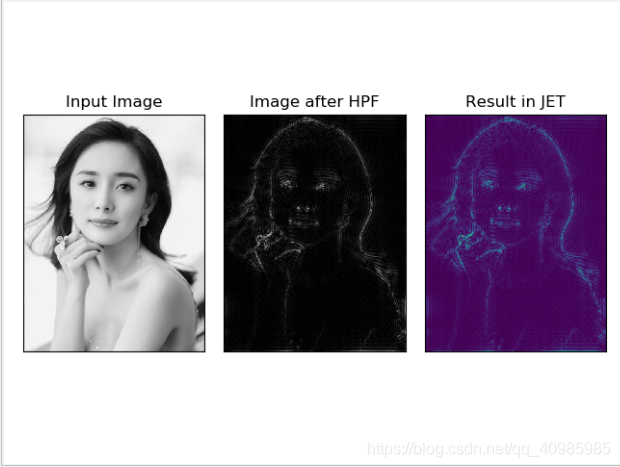

OpenCV中的图像变换——傅里叶变换
source link: https://blog.csdn.net/qq_40985985/article/details/119007945
Go to the source link to view the article. You can view the picture content, updated content and better typesetting reading experience. If the link is broken, please click the button below to view the snapshot at that time.

这篇博客将介绍OpenCV中的图像变换,包括用Numpy、OpenCV计算图像的傅里叶变换,以及傅里叶变换的一些应用;
2D Discrete Fourier Transform (DFT)二维离散傅里叶变换
Fast Fourier Transform (FFT) 快速傅里叶变换
傅立叶变换用于分析各种滤波器的频率特性。对于图像采用二维离散傅立叶变换(DFT)求频域。一种称为快速傅立叶变换(FFT)的快速算法用于DFT的计算。
- OpenCV使用cv2.dft()、cv2.idft() 实现傅里叶变换,效率更高一些(比OpenCV快3倍)
- Numpy使用np.ifft2() 、np.fft.ifftshift() 实现傅里叶变换,使用更友好一些;
1. 效果图
灰度图 VS 傅里叶变换效果图如下:
可以看到白色区域大多在中心,显示低频率的内容比较多。
傅里叶变换去掉低频内容后效果图如下:
可以看到使用矩形滤波后,效果并不好,有波纹的振铃效果;用高斯滤波能好点;
傅里叶变换去掉高频内容后效果图如下:
删除图像中的高频内容,即将LPF应用于图像,它实际上模糊了图像。
各滤波器是 HPF(High Pass Filter)还是 LPF(Low Pass Filter),一目了然:
拉普拉斯是高频滤波器;
- DFT的性能优化:在一定的阵列尺寸下,DFT计算的性能较好。当数组大小为2的幂时,速度最快。大小为2、3和5的乘积的数组也可以非常有效地处理。
为达到最佳性能,可以通过OpenCV提供的函数cv2.getOptimalDFTSize() 寻找最佳尺寸。
然后将图像填充成最佳性能大小的阵列,对于OpenCV,必须手动填充零。但是对于Numpy,可以指定FFT计算的新大小,会自动填充零。
通过使用最优阵列,基本能提升4倍的效率。而OpenCV本身比Numpy效率快近3倍;
拉普拉斯是高通滤波器(High Pass Filter)
3.1 Numpy实现傅里叶变换
# 傅里叶变换
import cv2
import numpy as np
from matplotlib import pyplot as plt
img = cv2.imread('ym3.jpg', 0)
# 使用Numpy实现傅里叶变换:fft包
# fft.fft2() 进行频率变换
# 参数1:输入图像的灰度图
# 参数2:>输入图像 用0填充; <输入图像 剪切输入图像; 不传递 返回输入图像
f = np.fft.fft2(img)
# 一旦得到结果,零频率分量(直流分量)将出现在左上角。
# 如果要将其置于中心,则需要使用np.fft.fftshift()将结果在两个方向上移动。
# 一旦找到了频率变换,就能找到幅度谱。
fshift = np.fft.fftshift(f)
magnitude_spectrum = 20 * np.log(np.abs(fshift))
plt.subplot(121), plt.imshow(img, cmap='gray')
plt.title('Input Image'), plt.xticks([]), plt.yticks([])
plt.subplot(122), plt.imshow(magnitude_spectrum, cmap='gray')
plt.title('Magnitude Spectrum'), plt.xticks([]), plt.yticks([])
plt.show()
# 找到了频率变换,就可以进行高通滤波和重建图像,也就是求逆DFT
rows, cols = img.shape
crow, ccol = rows // 2, cols // 2
fshift[crow - 30:crow + 30, ccol - 30:ccol + 30] = 0
f_ishift = np.fft.ifftshift(fshift)
img_back = np.fft.ifft2(f_ishift)
img_back = np.abs(img_back)
# 图像渐变章节学习到:高通滤波是一种边缘检测操作。这也表明大部分图像数据存在于频谱的低频区域。
# 仔细观察结果可以看到最后一张用JET颜色显示的图像,有一些瑕疵(它显示了一些波纹状的结构,这就是所谓的振铃效应。)
# 这是由于用矩形窗口mask造成的,掩码mask被转换为sinc形状,从而导致此问题。所以矩形窗口不用于过滤,更好的选择是高斯mask。)
plt.subplot(131), plt.imshow(img, cmap='gray')
plt.title('Input Image'), plt.xticks([]), plt.yticks([])
plt.subplot(132), plt.imshow(img_back, cmap='gray')
plt.title('Image after HPF'), plt.xticks([]), plt.yticks([])
plt.subplot(133), plt.imshow(img_back)
plt.title('Result in JET'), plt.xticks([]), plt.yticks([])
plt.show()
3.2 OpenCV实现傅里叶变换
import cv2
import numpy as np
from matplotlib import pyplot as plt
img = cv2.imread('ym3.jpg', 0)
rows, cols = img.shape
print(rows, cols)
# 计算DFT效率最佳的尺寸
nrows = cv2.getOptimalDFTSize(rows)
ncols = cv2.getOptimalDFTSize(cols)
print(nrows, ncols)
nimg = np.zeros((nrows, ncols))
nimg[:rows, :cols] = img
img = nimg
# OpenCV计算快速傅里叶变换,输入图像应首先转换为np.float32,然后使用函数cv2.dft()和cv2.idft()。
# 返回结果与Numpy相同,但有两个通道。第一个通道为有结果的实部,第二个通道为有结果的虚部。
dft = cv2.dft(np.float32(img), flags=cv2.DFT_COMPLEX_OUTPUT)
dft_shift = np.fft.fftshift(dft)
magnitude_spectrum = 20 * np.log(cv2.magnitude(dft_shift[:, :, 0], dft_shift[:, :, 1]))
plt.subplot(121), plt.imshow(img, cmap='gray')
plt.title('Input Image'), plt.xticks([]), plt.yticks([])
plt.subplot(122), plt.imshow(magnitude_spectrum, cmap='gray')
plt.title('Magnitude Spectrum'), plt.xticks([]), plt.yticks([])
plt.show()
rows, cols = img.shape
crow, ccol = rows // 2, cols // 2
# 首先创建一个mask,中心正方形为1,其他均为0
# 如何删除图像中的高频内容,即我们将LPF应用于图像。它实际上模糊了图像。
# 为此首先创建一个在低频时具有高值的掩码,即传递LF内容,在HF区域为0。
mask = np.zeros((rows, cols, 2), np.uint8)
mask[crow - 30:crow + 30, ccol - 30:ccol + 30] = 1
# 应用掩码Mask和求逆DTF
fshift = dft_shift * mask
f_ishift = np.fft.ifftshift(fshift)
img_back = cv2.idft(f_ishift)
img_back = cv2.magnitude(img_back[:, :, 0], img_back[:, :, 1])
plt.subplot(121), plt.imshow(img, cmap='gray')
plt.title('Input Image'), plt.xticks([]), plt.yticks([])
plt.subplot(122), plt.imshow(img_back, cmap='gray')
plt.title('Magnitude Spectrum'), plt.xticks([]), plt.yticks([])
plt.show()
3.3 HPF or LPF?
import cv2
import numpy as np
from matplotlib import pyplot as plt
# 简单的均值滤波
mean_filter = np.ones((3, 3))
# 构建高斯滤波
x = cv2.getGaussianKernel(5, 10)
gaussian = x * x.T
# 不同的边缘检测算法Scharr-x方向
scharr = np.array([[-3, 0, 3],
[-10, 0, 10],
[-3, 0, 3]])
# Sobel_x
sobel_x = np.array([[-1, 0, 1],
[-2, 0, 2],
[-1, 0, 1]])
# Sobel_y
sobel_y = np.array([[-1, -2, -1],
[0, 0, 0],
[1, 2, 1]])
# 拉普拉斯
laplacian = np.array([[0, 1, 0],
[1, -4, 1],
[0, 1, 0]])
filters = [mean_filter, gaussian, laplacian, sobel_x, sobel_y, scharr]
filter_name = ['mean_filter', 'gaussian', 'laplacian', 'sobel_x', \
'sobel_y', 'scharr_x']
fft_filters = [np.fft.fft2(x) for x in filters]
fft_shift = [np.fft.fftshift(y) for y in fft_filters]
mag_spectrum = [np.log(np.abs(z) + 1) for z in fft_shift]
for i in range(6):
plt.subplot(2, 3, i + 1), plt.imshow(mag_spectrum[i], cmap='gray')
plt.title(filter_name[i]), plt.xticks([]), plt.yticks([])
plt.show()
Recommend
About Joyk
Aggregate valuable and interesting links.
Joyk means Joy of geeK